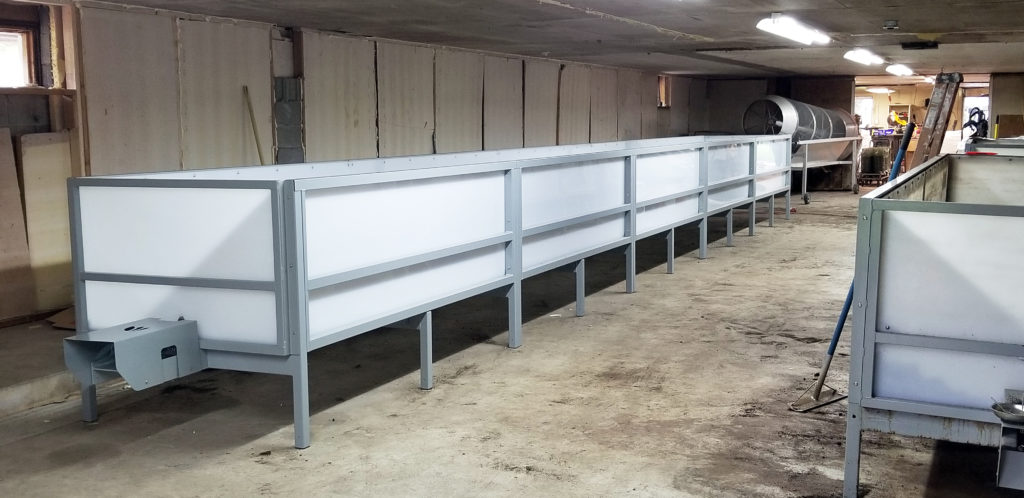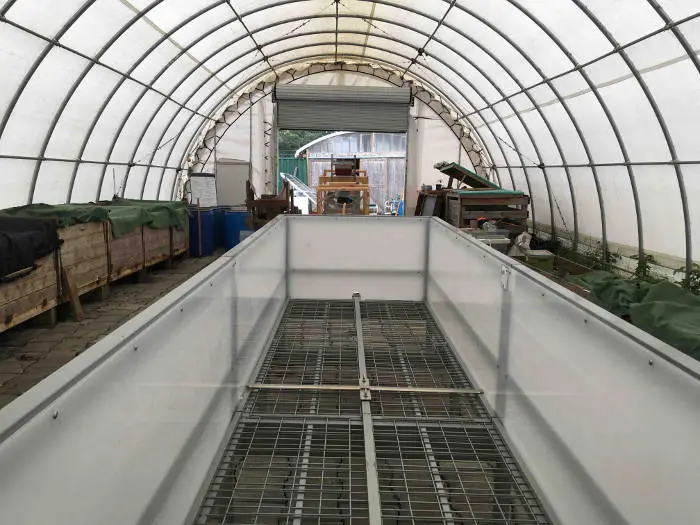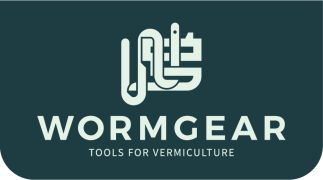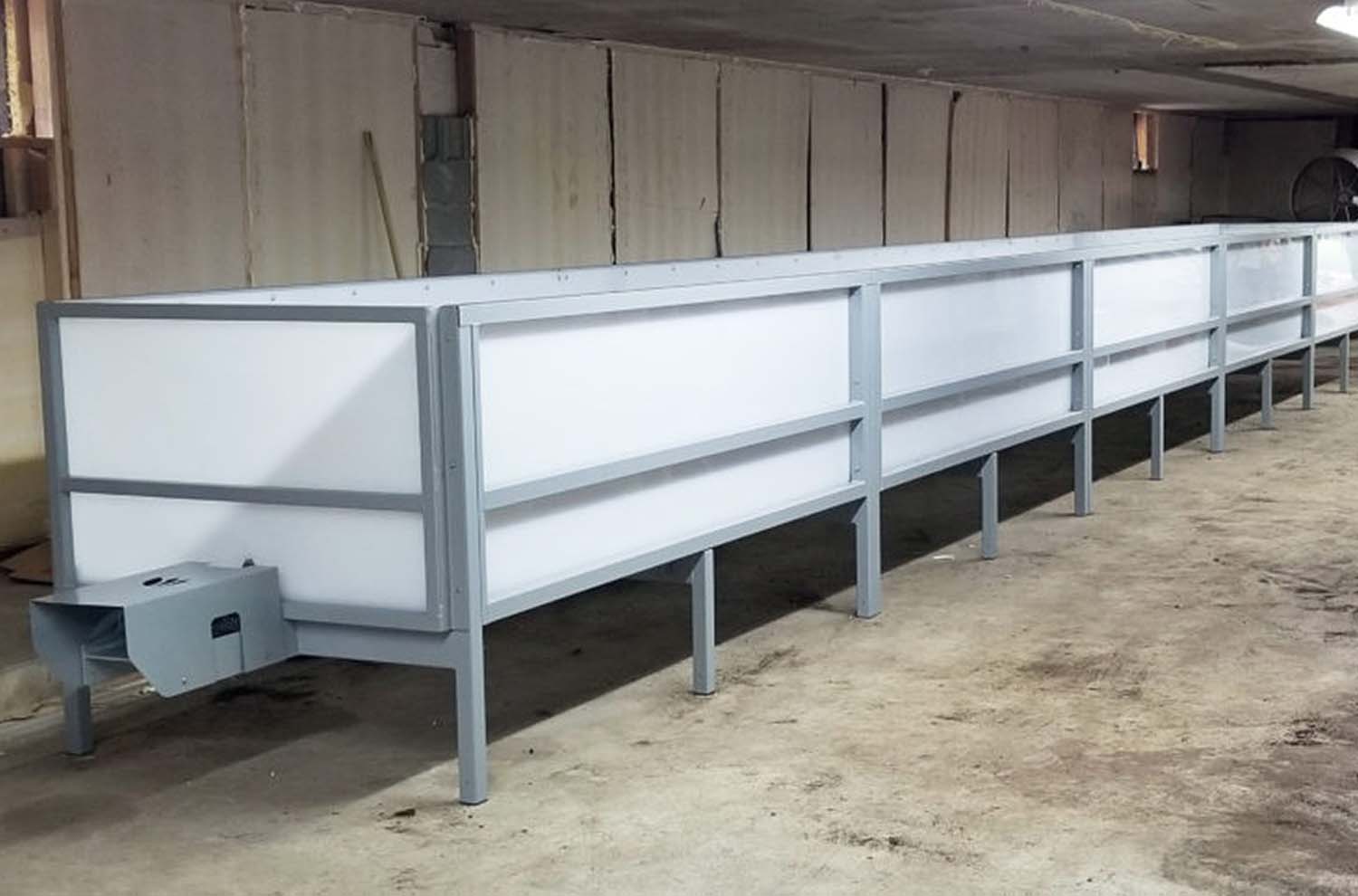The following conditions need to be met:
You’ll need to avoid direct sunlight, temperature extremes, and downpours. So your vermicomposting system must be located indoors or under shelter; someplace you can control the elements.
You’ll need room to work around your machine, so plan for space on the side for feeding, watering and harvesting, and access at the ends for operating the controls or winches.
Every installation has its challenges! Our CFTs have been installed in plenty of challenging conditions – in narrow sea containers, in the tropics, you name it. Most hurdles can be overcome one way or another. So don’t worry that your installation doesn’t meet all the recommendations that follow.
But for your starting point, here’s what you need to keep in mind when laying out a new area.

40-ft CFT in WormCycle’s Detroit-area operation. Note the central working space between the CFTs and the low ceiling.
Space Requirements for a Wormgear CFT
Flooring
Continuous flow vermicomposting systems are harvested from the bottom, so you’ll want a solid floor surface or you’ll need large trays to catch the vermicompost. Gravel and earthen surfaces don’t work well for moving the finished product, and wood floors can eventually deteriorate from the dampness. The best approach is to keep your CFT on a concrete or asphalt pad, whether in a building or under a canopy.
Ceiling Height
A low ceiling of 7 ft (210 cm) works fine for mostly manual feeding in small installations.
If mechanical equipment is to be used, such as a front-end loader, feeding cart or conveyors, then 11 ft (330 cm) of vertical clearance will be needed.
Utilities
You are likely to need access to electricity, whether for lights, heat, fan or the CFT motor drive. Also, you’ll want nearby access to clean water.
Space for Work Area
You’ll need a wide aisle alongside the CFT for feeding and harvesting plus room to maneuver. Allow enough space for working with long-handled tools. A minimum of 7 ft (2 m) from the CFT side wall to other barriers is advised in most cases.
Also you’ll need room for buckets, harvested piles, screens, watering cans and garden tools – whether in that same space or an adjacent area.
Access at Ends
You’ll need standing room at each end to operate the motor or winches. Plan on positioning your CFT so that its legs are at least 5 ft (1.5 m) from a wall, column or other fixed object, giving you 3 ft or more for standing room.
Access at Back
Usually there is no need for access at the back of the CFT, except occasionally to sweep up any out-of-reach vermicompost or to reach into the bin from the back side. For that reason, position the CFT 3 ft (1 m) or more from a back wall. If your enclosure has columns, it is fine to locate the CFT against the columns.
Use the following guidelines to determine a minimum space for your operation. In this example, we’ll assume a single module.
Room Length: 18 feet
16-ft CFT installed in a hoop house at ECO City Farm near Washington DC.
This assumes 5 feet at each end plus the length of the CFT and winch mechanism.
Room Width: 15 feet
This assumes 8 feet of working area, 3 feet of clearance to the back wall and the 4-foot width of the CFT.
Lastly, with multiple CFT lines it is efficient to arrange lines in pairs side by side, sharing a common work aisle.

16-ft CFT installed in a hoop house at ECO City Farm near Washington DC.
Climate Conditions for Effective Vermicomposting
Temperature
Worms can adapt to a range of temperatures but are most productive between 60° and 85°F (15° to 30°C).
They can tolerate extremes to near-freezing and as high as 95°F (35°C). But at these limits, they will go into survival mode and there may be some loss of population. If it is a short duration they will recover just fine.
In milder climates, the CFT can be located outdoors under a shade canopy and exposed to the cooling breeze. In more temperate climates, your bin must be protected from harsh conditions. In winter months, it is usually enough to keep the bin at 40°F (5°C) or above.
A low or enclosed ceiling can help with maintaining the room temperature.
Light
Composting worms will avoid daylight. If exposed to direct sunlight, they will soon burrow below the surface. Direct sunlight also dries out the surface and builds up heat in the top layers.
In dark conditions, they will often rummage happily on the surface.
Water
The composting bed should not be exposed to a drenching downpour. The bed should remain moist but not saturated.
The worms and microorganisms in the bed need a balance of moisture and oxygen to remain productive. Too much moisture can result in leaching and anaerobic conditions which are counterproductive.
Air Circulation
A cooling breeze can go a long way to reduce high temperatures, whether from open walls or windows or a large fan. Just monitor moisture levels as a dry breeze can evaporate moisture away from the top surface. Too much wind can evaporate the moisture and increase the need for more watering.
Contact Wormgear
If you have doubts about the best solution for your site, it can be helpful to talk with someone who’s done it before. E-Mail us or give us a call at 248-938-9311 to discuss your commercial vermicomposting operation. We’re always happy to explore options with you!


